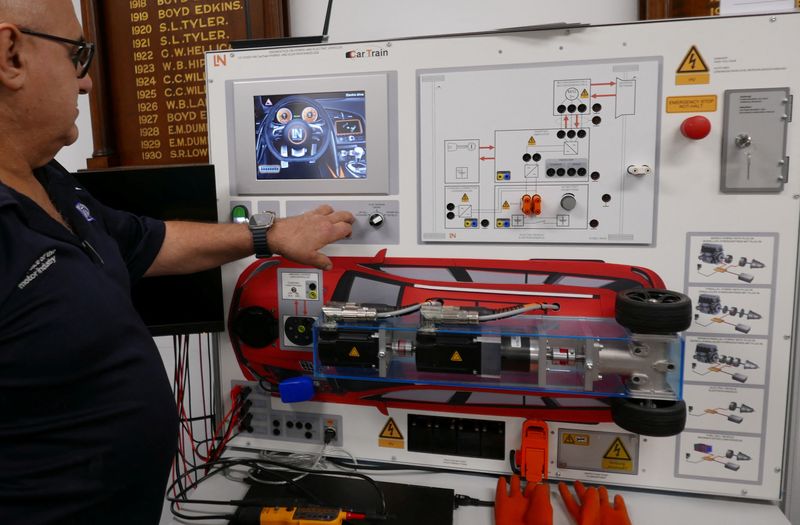(This May 17 story has been corrected to say the rollout of chargers started small due to grid issues, not scaled back due to grid issues, and changes month to October, not November, in paragraph 18)
By Lewis Jackson
SYDNEY (Reuters) - Australians are starting to buy electric vehicles in large numbers, and the government is trying to accelerate the adoption of cleaner cars, but industry executives say installing chargers rapidly enough to meet the boom will not be easy.
Environmentally conscious Australians keen for electric vehicles got a boost last month when the government announced plans to set vehicle emissions standards in the last developed country bar Russia without them, to help fix a shortage of EVs.
But public charging infrastructure remains sparse and under-powered by global standards, according to International Energy Agency data, a potential deterrent for mass EV takeup in a vast country where chargers remain scarce outside cities.
Australia has less than a third the number of public chargers for every EV on the road compared with the global average, despite being home to one of the world's most successful charger manufacturers, Tritium DCFC.
Challenges obtaining equipment, delays plugging public chargers into the grid and shaky economics mean a mass build-out cannot be done overnight, industry executives said.
"All of that takes a long time, so you won't physically see chargers popping up everywhere over the next year," said Carly Irving-Dolan, chief executive of NRMA Energy and Infrastructure.
NRMA, a motoring services organisation, is partnering with government to build 135 charging sites across the national highway network over the next two to three years, adding to the 2,392 sites currently available around Australia.
After a decade under a conservative government that opposed EV adoption, the country's Labor government, which won power a year ago, has launched a national EV strategy and doubled funding for cleaner transport to A$500 million ($339 million).
Electric vehicles sales are already trending up, accounting for 8% of all car sales in April, up from 1.1% a year earlier.
DEMAND UNCERTAINTY
Despite the government's EV push, uncertainty remains over how tough its vehicle emission standards will be.
The risk is weak standards leave Australia a dumping ground for dirty cars, limit the supply of new EVs and undermine the economics of charge operators, said Geoff Brady, chief operating officer at electric charger operator Evie Networks.
"We're building infrastructure in advance of demand to support the transition. If the cars aren't on the road, that's a risk for our economics," Brady said.
If the new standards work to incentivise automakers to import sufficient clean cars, Australians will finally see a wider range of EVs in a market where roughly half of all EVs sold in 2022 were made by Tesla (NASDAQ:TSLA).
To help get over the cloudy economics of installing chargers, the federal and state governments have been helping fund rollouts, including backing NRMA and Evie Networks.
PLUGGING IN
Australia's abundant sunshine and the world's highest per capita uptake of rooftop solar means home charging is not a major problem. The challenge is the expansion of public chargers, especially in regional areas, where the power infrastructure to support fast chargers is often scarce or absent.
The country's public chargers tend to be underpowered, with 0.5 kilowatts of public charging per EV versus an average 2.4 kw worldwide.
Expansion of public chargers is slow as operators face long delays connecting to the grid. An Evie report filed to the government funding administrator in October said the process of connecting to the grid was "expensive and inefficient".
BP (LON:BP) is aiming for roughly 300 chargers across its petrol stations in Australia by the end of 2024. The rollout, which began last October, started with a single 75kW charger per site in part because of issues getting more capacity from the grid, said Andrew Worboyes, EV operations manager at BP Pulse.
Installing multiple chargers or high-powered units can add up to 12 months to a project, and massive global demand means up to 18-month waits for ultra-fast chargers ordered today, he said. Irving-Dolan said NRMA had four- to six-month waits.
"The lead times are one of the biggest problems that the average punter who buys an EV and expects to see a fast charger everywhere doesn't understand," Worboyes said.
Numerous studies must be done to make sure chargers, which often use as much power as several homes or businesses, do not dim the lights for existing customers, said Ausgrid Chief Customer Officer Rob Amphlett Lewis, which runs the biggest transmission network in New South Wales, Australia's most populous state.

"It's like the introduction of mass air conditioning in the '90s and early 2000s, it will take big investment," Lewis said.
($1 = 1.4743 Australian dollars)